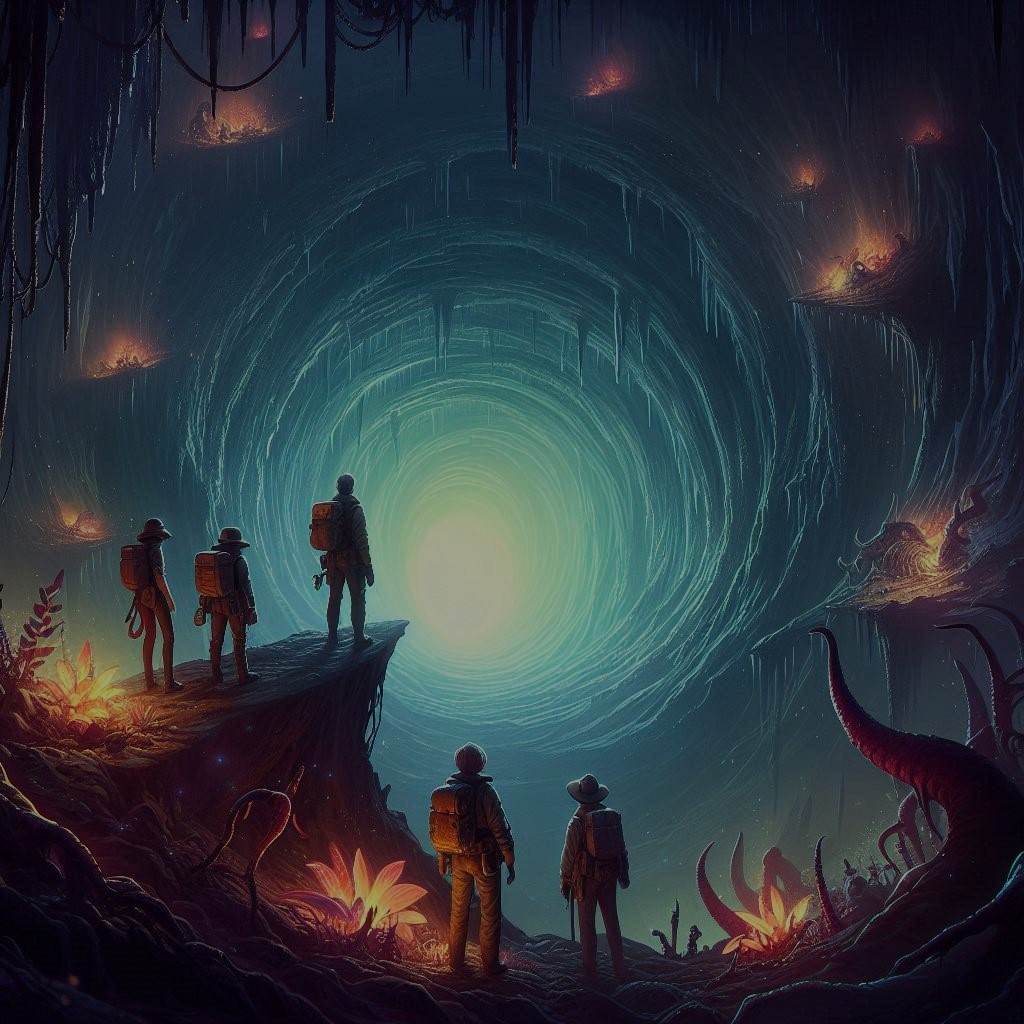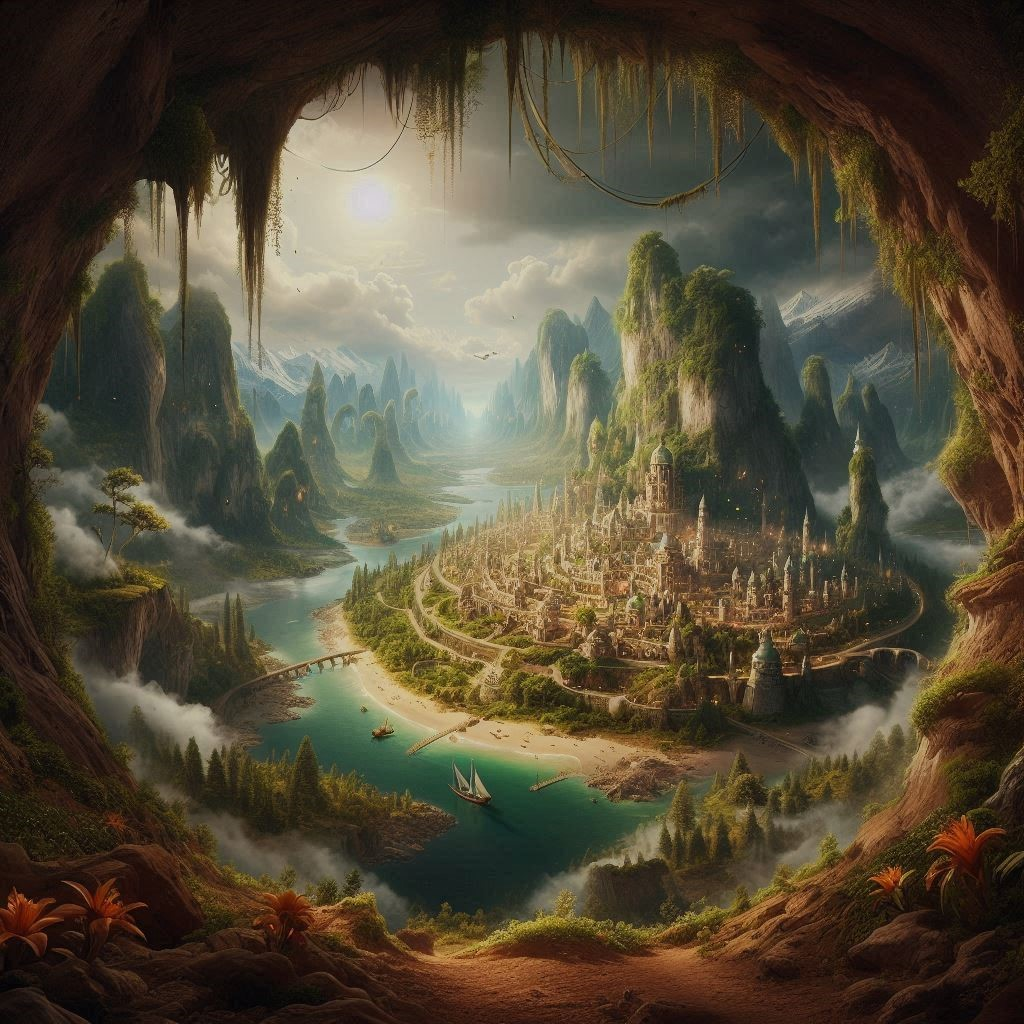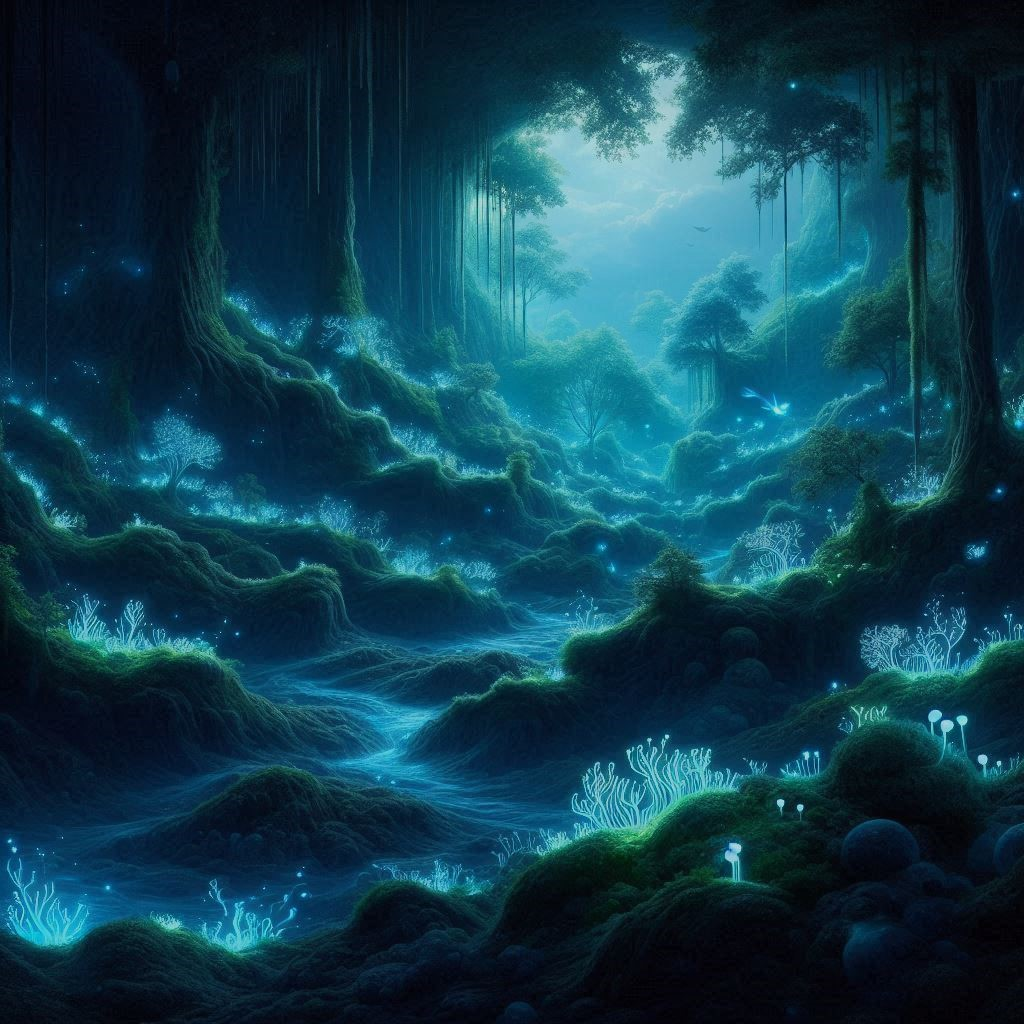The concept of an underground world inhabited by advanced beings has been around for centuries, with stories and legends passed down through generations. Agartha, the Inner Earth kingdom, attract those who seek answers beyond the surface.
Agartha has been regarded as an ultimate sanctuary by some and the perfect world (community) blueprint by the others. Whether you see it as an existing mystical realm, a metaphor, or a source of inspiration, it invites us to explore the depths of our own consciousness.
So, let’s find out more about Agartha, and also about its connection to the Hollow Earth.

The image was created by the author of this article and is purely for decorative purposes.
Table of Contents
The Hollow Earth Theory
The theory traces its roots back to the late 17th century, when it was suggested by Edmond Halley. It proposes that our planet is either entirely hollow or that it contains a massive interior space.
Here are the key ideas of the theory:
Nested Shells
Earth’s interior comprises spherical shells spinning in different directions around a central core. These shells create a vast cavern within our planet, potentially harboring life and unique ecosystems.
Inner Sun
Within this hollow space, advocates of the theory envision a small, radiant sun. This inner sun provides warmth, light, and sustenance to the inhabitants of the Hollow Earth.
Healthier Beings
The theory suggests that the beings residing in such inner world are larger, healthier, and more advanced than those beings on the surface. Their environment remains pristine, shielded from pollution and external influences.
This theory is nowadays widely considered as disproven (not scientifically viable). However, its elements are strongly present in conspiracy theories about hidden civilizations, folklore, books, movies, art…
Agartha: The Inner Earth Kingdom
Name and Legend Origins
Agartha has become kind of interchangeable with the Hollow Earth term. It can be looked at as a concrete, more detailed “version” of the Hollow Earth theory.
It is also known as: Agartta, Agharti, Agarta… Apparently, the origin of the name was derived either from: the Greek feminine name Agathe (meaning good, fit, noble), or from Indian (Sanskrit) language, with the possible meanings: unreachable, inner soul, inner Earth. The exact etymology is uncertain, but its Sanskrit roots underscore the ancient and mystical nature of the legend.
One of the earliest references to a subterranean world comes from Hindu mythology, which describes Patala, a realm beneath the Earth’s surface inhabited by serpent-like beings called Nagas. Patala is often depicted as a paradise with advanced technology and great wisdom.
Buddhist traditions, particularly those from Tibet, introduce the concept of Shambhala, a hidden kingdom of enlightened beings located in a remote area, often considered synonymous with Agartha. The Kalachakra teachings of Tibetan Buddhism speak of Shambhala as a place where a future king will emerge to guide humanity during times of great turmoil, aligning with the idea of Agartha as a source of ultimate wisdom and salvation.
The legend became more popular in the 19th century and started to emphase more on Agartha as being a home to a civilization, accessible through entrances at the Earth’s poles or other remote locations.
Inhabitants of Agartha
The inhabitants of Agartha are called Agarthans or Inner Earth Beings. Legends suggest that Agartha’s inhabitants are survivors of ancient cataclysms (such as the sinking of Atlantis or Lemuria).
Agarthans are said to be highly advanced beings, possessing advanced technology, knowledge, spiritual wisdom, and longevity. Thriving in vibrant health, nourished by copper-rich water, they are described as being tall, having a green-tinted skin, but still possesing human-like characteristics. Their appearance is luminous, radiant, with a physical form that is said to be more refined and ethereal compared to humans. They wear clothing that is simple yet elegant, sometimes including symbols and designs that reflect their advanced culture and knowledge.
Agarthans are perceived as peaceful, enlightened, and in harmony with nature. Their mission is to protect the environment, promote peace, harmony in all aspects, and guide humanity toward sustainability and wellness. It is believed that, due to their ultra sharp psychic abilities, Agarthans can exist in both physical and spiritual realms simultaneously, which helps them connect with certain people and other beings.
Agartha is often mentioned in the context of Agarthan Starseeds, although now there might be a confusion about the “starseeds” part. Apparently, the Agarthans are bound to the very Agartha’s area, while, on the other hand, Agarthan Starseeds did originate from Agartha but incarnated on the surface of Earth, living human lives. They are emissaries or messengers, whose purpose is to directly aid in the spiritual development and evolution of humanity.
All these concepts are deeply embedded in New Age spirituality and metaphysical thought, and they are not recognized or supported by mainstream science or empirical evidence. Scientific exploration tends to focus on observable phenomena and evidence-based research.
The Capital City
Agartha’s capital city is Shambhala, sometimes spelt differently or even called Shangri-La. It holds a prominent place in both Eastern spiritual traditions and Western esoteric thought. Derived from Sanskrit, Shambhala means place of peace or place of silence, reflecting its status as a utopian realm of harmony and enlightenment.
According to the legend, Shambhala is a city of extraordinary beauty and brilliance, hidden from the eyes of the unworthy and accessible only to those with pure hearts and high spiritual awareness. Some consider it to be both a physical and spiritual realm, bridging the mystical and tangible worlds.
Shangri-La is nowadays widely used as a term to describe an imaginary, remote paradise on Earth; a place of complete bliss and delight and peace.

The image was created by the author of this article and is purely for decorative purposes.
Entrance Points
Over the years, various texts and theories have proposed multiple entrance points to Agartha. There were also a corresponding expeditions taking place. We’re going to list the most mentioned ones below.
The North and South Poles
One of the most popular theories suggests that there are vast openings at the Earth’s poles leading to Agartha. This idea gained prominence through the writings of early 20th-century explorers and authors who claimed that polar expeditions revealed massive entrances to the inner Earth. A legend says that these polar portals are guarded by advanced beings and are “accessible only to those deemed worthy”.
One of the most famous names associated with polar exploration and the legend of Agartha is Admiral Richard E. Byrd. During his 1947 Antarctic expedition, Byrd reportedly flew over the South Pole and described seeing vast, unexplored lands that some enthusiasts claim were the entrances to the inner Earth. This and other claims are largely based on a various interpretations of his diaries and writings.
Mount Shasta, California
Mount Shasta, a volcanic peak in Northern California, is often mentioned as an entrance to Agartha. The mountain has long been associated with mystical phenomena and is adored by Native Americans. Some seekers claim that hidden tunnels and passageways beneath Mount Shasta lead to the inner world of Agartha. The mountain is also said to be home to the Lemurians, an ancient race believed to have retreated underground thousands of years ago.
Numerous groups and individuals have conducted expeditions to the mountain, and while they didn’t provide any empirical proof, they have contributed to the mountain’s mystical reputation.
The Himalayas
Magnificent Himalayas, particularly in regions bordering Tibet and Nepal, are another proposed entry point to Agartha. This theory aligns with Buddhist and Hindu legends that speak of Shambhala, a hidden kingdom of enlightened beings. In this case, Agartha and Shambhala are interconnected, with secret tunnels and passages linking them to the surface world.
The Russian artist, philosopher, and explorer Nicholas Roerich conducted expeditions to the Himalayas in the 1920s and 1930s. Roerich’s journeys were inspired by the search for Shambhala, a legendary kingdom that some equate with Agartha.
He was in contact with a certain spiritual masters, as he called them “Mahatmas”, and in the Himalayas, those masters were communicating with Roerich telepathically (through his wife, Helena, who was a mystic and a clairvoyant). Roerich’s writings and artwork are related to his fascination with the mystical aspects of the region.
The Amazon Rainforest
It is believed that there are hidden entrances to Agartha, deep within the Amazon Rainforest. Indigenous tribes have long spoken of a hidden world beneath the jungle floor, accessible through caves and tunnels. These tales are often intertwined with the broader mythology of lost civilizations and hidden treasures within the forest.
British explorer Percy Fawcett embarked on a several expeditions to the Amazon in the early 20th century. Fawcett was searching for a lost city he referred to as “Z,” which some theorists believe could be connected to the legends of Agartha. Unfortunately, Fawcett’s final expedition in 1925 ended with his mysterious disappearance, adding to the beliefs related to the Amazon’s hidden secrets.
Giza Plateau, Egypt
The Giza Plateau, home to the Great Pyramid and the Sphinx, is another location often linked to the entrances of Agartha. Some theories propose that there are ancient tunnels and chambers beneath the pyramids that lead to the inner Earth. These ideas are supported by various esoteric writings and the enduring mystery surrounding the construction and the actual purpose of the pyramids.
Numerous archaeological expeditions have explored the Giza Plateau, uncovering many tunnels and chambers beneath the pyramids. However, no discoveries have linked these tunnels to Agartha, yet. The plateau keeps fuelling the theories, with some believing that undiscovered passages still lie hidden beneath the sands.
Antarctica
Antarctica is another region frequently mentioned in connection with Agartha. There are conspiracy theories suggesting that Nazi Germany conducted secret expeditions to Antarctica during World War II, allegedly discovering entrances to Agartha. These theories are often linked with stories of advanced technology and hidden bases beneath the ice. However, they are largely based on speculation and still lack credible evidence.

Photo by Patrik Felker
The Guardians of Agartha
According to some beliefs, there are ancient beings who inhabit or guard the very entrances to Agartha, and those beings are called Asuras.
Often described as powerful and ambitious but morally ambiguous or malevolent, they don’t seem to fit the Agartha narative at the first glance. However, their actions and characteristics can be complex, sometimes embodying noble traits like devotion and determination.
Spiritual Aspects
From a spiritual perspective, Agartha is a captivating concept that has inspired various interpretations and beliefs over the years. We’re going to list some of them below.
Inner Wisdom and Enlightenment
Agartha is often seen as a metaphorical representation of inner wisdom, enlightenment, and self-realization. It symbolizes the journey within, where seekers explore their own depths to discover hidden truths and higher consciousness.
Unity and Harmony
Agartha embodies the idea of a harmonious and interconnected world. It is believed that its inhabitants live in peace, wisdom, and unity. Some spiritual traditions consider Agartha a place where all beings coexist without conflict, transcending divisions and material concerns.
Energetic Vortex
Some esoteric teachings suggest that Agartha contains powerful energy vortexes or ley lines that enhance spiritual growth and healing. Seekers may meditate on Agartha’s energy centers to align themselves with higher frequencies. (While writing this article, a thought crossed our minds – how the feeling of being grounded after spending some time in the nature (close to the ground) actually comes from Agartha’s vibrations. Ha! Imagine that! 😀 ).
Ascended Masters and Guardians
As we’ve mentioned, Agartha is said to be inhabited by advanced beings, (including ascended masters), who guide humanity’s evolution.
Now, according to some sources, seekers may contact these benevolent guardians for guidance, healing, and spiritual support, during meditation or inner journey sessions (since their telepathic abilities are very strong).
Some people said that they often visualize themselves entering Agartha to receive healing or to recharge their energy centers. According to some sources, that can only be achieved if your frequency is the right one, and your intentions and goals are nothing but pure and benevolent.
There’s an interesting contrasting symbolism: Asuras, the proposed guardians of Agartha (mentioned earlier in this article), kind of represent the inner struggles and the journey of spiritual growth. Just as they represent inner demons to overcome, Agartha represents a hidden, enlightened state within the Earth and, metaphorically, within oneself.

The image was created by the author of this article and is purely for decorative purposes.
Influence on Popular Culture
Literature and Films
Agartha has been a very popular theme in literature and films. Various authors and filmmakers have used the concept of Agartha in their works, mostly referring to it as The Hollow Earth, often portraying it as a mysterious and mystical place.
One of the most famous works of literature that features The Hollow Earth is the novel “Journey to the Center of the Earth” by Jules Verne. In the novel, the protagonist discovers a passage that leads to the center of the Earth, where he encounters a world that is home to prehistoric creatures and the lost city of Atlantis.
In addition to literature, The Hollow Earth has also been featured in several films. One of the most notable films is “Indiana Jones and the Hollow Earth” which features the protagonist embarking on a quest to find the entrance to the hidden world.
TV Programme and Documentaries
Television programs have delved into the Hollow Earth theory, blending elements of science fiction, mystery, and adventure. Shows like “The X-Files” and “Ancient Aliens” have featured episodes discussing the possibility of an inner world, drawing on myths, legends, and speculative science.
Documentaries and videos on platforms like YouTube have also played a significant role in popularizing the Hollow Earth theory. Recently, more and more independent filmmakers and researchers started creating content exploring the theory’s various aspects, via the independent documentaries, video montages, vlogs, podcasts…
Video Games and Animation
The Hollow Earth has also been a popular theme in video games and animation. Many games and animated series have used the concept of it as a central plot point. We haven’t had a chance to delve into any of them yet, but maybe you already have. 🙂
Various Forms of Art
The Hollow Earth theory has not only captivated the realms of media and literature but has also found a place in various forms of art, including paintings, sculptures, and installations. Artists often draw upon the rich mythology and speculative nature of the Hollow Earth concept to explore themes of mystery, the unknown, and the intersection of science and fantasy.
Online Communities
Online content, including blogs, articles, and forums, offers lots of information and discussion on the Hollow Earth theory. Websites dedicated to conspiracy theories and alternative history often feature detailed articles on the subject, exploring everything from ancient myths to modern expeditions.
Social media platforms also host vibrant communities, where people share theories, discuss new findings, and debate the validity of various claims. These online platforms allow a dynamic exchange of ideas to happen, keeping the Hollow Earth theory alive.
Conclusion
Agartha, or The Hollow Earth, remains an enigma that sparks curiosity, imagination, and wonder. Whether factual or mythical for some, its allure persists, and as previously mentioned, it’s inviting us to explore the mysteries that lie beneath our feet, but also deep within ourselves.
We’d love to hear what you think about this topic in the comments below – feel free to share your knowledge on it, or even tell us how you envision this magical, mythical kingdom!
